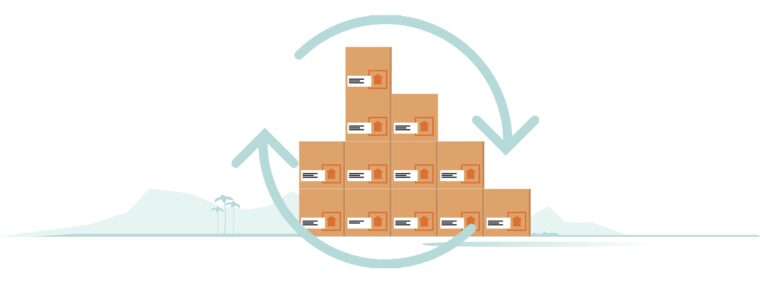The biggest unnecessary expense in e-commerce operations
To learn where organizations can find the biggest profit in dealing with returns management, we talked with all-round operational expert and Site Manager at BuyBay: John Warnar.

2021 – what a year! There are many things that we’ll certainly remember for a long time. For sure, the pandemic-related measures had noticeable consequences for retailers. The trend towards online trading increased rapidly. To illustrate, Dutch consumers spent 26.6 billion euros at webshops in 2020, a growth of 7 percent compared to 2019. The total number of online purchases in 2020 rose 27 percent to 335 million.
The e-commerce boom also triggered additional changes – e.g., in the market landscape. After a long period of consolidation, the competition increased, and new providers established themselves on the market. The study “The Marketplace World 2020” lists more than 170 different marketplaces in the DACH region alone – not to mention the numerous specialized online shops. At the same time, we saw a change in the purchasing behavior of many consumers. They are becoming more demanding, and they are also paying more attention to criteria such as sustainability. Observing these developments, we believe “Re-commerce” will be one of the megatrends for 2022.
The term “re-commerce” is derived from the term e-commerce for “electronic commerce” or “electronic trade” and the word “re” for “again” and is also linked to the expression “reversed commerce”. It stands for the resale of returned, new or used products. These are usually checked and, if necessary, repaired or reconditioned and then sold again. This brings them back into the consumption cycle.

The UN Climate Change Conference in Glasgow showed that acting sustainably is not a luxury but a necessity. Corporate Social Responsibility (CSR) has moved very high up on the 2022 agenda of many companies. On the one hand, many companies feel they have a responsibility and want to make a targeted contribution to a more sustainable economy and society. On the other hand, they are also made responsible by laws or regulations. These address, for example, the handling of products that contain electrical components: from smartphones and computers to coffee machines or refrigerators.
Electronic waste is a sore point on the global and European sustainability agenda. Statistics estimate that we currently produce ca. 57,5 million tons per year and expect this number to reach nearly 75 million tons by 2030. The amended Electrical and Electronic Equipment Act (ElektroG) provides new obligations to take back electrical equipment and provide consumers with better information. Dealers will have additional responsibilities as part of Germany’s Recycling Management Act (KrWG). This, e.g., includes a ban on “removing electrical and electronic equipment from the market” (meaning destroying returned or defective devices) if they could still be used after repair or reconditioning. Therefore, in 2022 many manufacturers and dealers will have to deal with processing and reselling electrical products.
The growing awareness of global environmental problems also influences consumers’ shopping behavior: 66 percent of consumers in a current CapGemini study from nine different countries choose products or services because of their “environmental friendliness”. The younger generations of buyers, in particular, prefer brands that represent a deeper meaning and purpose in an authentic and understandable manner, and they also demand ethical behavior from retailers. According to analysts, the attitude of this group has a massive impact on consumer behavior. They consciously use their influence and purchasing power to enforce their values.
Surveys show that more and more consumers are actively looking for used goods, refurbished, and resold items: Seven out of ten respondents said they have tried or would like to buy used, repaired, or reconditioned products—84 percent of those who have tried this plan to continue shopping this way in the future. The interest in actively supporting a “circular economy” is even more substantial among Generation Z and Millennials: Almost eight out of ten respondents said they had bought or wanted to buy used products.
The buyers themselves are thus a driving force behind the re-commerce boom in online retail. According to current statistics, 78 percent of consumers prefer to buy used goods online rather than in brick-and-mortar stores. Therefore, this year we saw more specialized re-commerce platforms and brands and online retailers who picked up on this trend. By 2022 we expect this movement to establish itself even more firmly in the mainstream.
Tying one’s brand image to sustainable actions is becoming more and more important for brand positioning. In the increasing competition of the highly competitive e-commerce market, the conscious use of resources, such as returned products, offers an excellent opportunity to stand out from the competition.
At the same time, the re-commerce business allows companies to reach new consumer groups. Because, while 42 percent of consumers buy used or re-commerce products because they conserve resources, the attractive price also plays a decisive role. Fifty-six percent of consumers want to save on purchases, and 36 percent buy used products that they would otherwise not be able to afford. Re-commerce products usually offer a desirable price-performance ratio. For example, buyers can purchase a product with a small scratch or other marginal defects at a significant discount compared to the brand-new counterpart.
At the same time, the re-commerce sale of returns, overstock, or slightly damaged products is also more profitable for the providers than many previous practices. When such goods are traditionally sold to bulk buyers, the products often achieve less than 10 percent of their original value. As re-commerce products, after a quality check, evaluation, and processing (if necessary), the goods can be sold much more profitably to new owners via marketplaces, auction platforms, or their online shop. Companies that cannot handle this in-house can also work with a specialized partner to manage these processes.
The number of specialized re-commerce platforms or vendors integrating re-commerce into their business practices grows, and we are excited to watch how this evolution will continue in 2022!
For companies, re-commerce sales offer many advantages: For example, they can make a targeted contribution to a more sustainable economy and society, tap into new and especially young buyer groups, and detect more profitable ways of finding new buyers for returned goods and overstock than selling them off to bulk buyers.
At BuyBay, we work towards our vision of Zero Waste in eCommerce. We see the more intelligent handling of goods and the optimization of returns management and related processes as an essential step towards achieving this goal. We support our partners in finding the best solution for them.